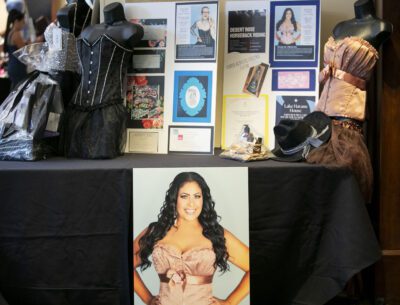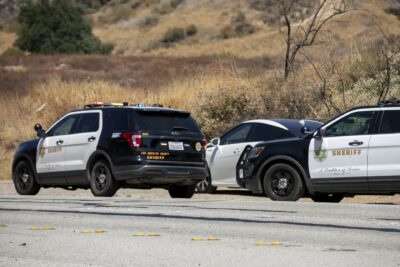We are about 20 minutes into spring. Like so many glorious past seasons, this again shall be a most vibrant and beautiful one. May the rest of 2025 be filled with good adventures for you.
Besides all the breathtaking scenery of yesterday we’ll be sharing on this Sunday’s time ride, there’s some other points of interest we’ll be perusing.
We’ve got Ruth Newhall’s epic Mexico adventure, the hanging of a local bandit and yet another page in the world records book dedicated to the Santa Clarita Valley.
C’mon, saddlepals. Left foot in the stirrup, a little bounce or 12 and in the saddle are we …
WAY, WAY BACK WHEN
THAT DARN TIBBY — He terrorized an entire state and owned property under many names here in the Santa Clarita. Tiburcio Vasquez once kidnapped an entire town. He held up pretty much anything that moved or didn’t and was perhaps most famous for his appetite for women. Indeed, they were his downfall and he was captured while visiting one of his many mistresses. He may be the only bandit and murderer to have a park named after him — in California at least. Neighboring Vasquez High School named their mascot after him. On March 19, at 1:35 p.m., Tibby was hanged in San Jose. His last words were a simple: “Pronto.”
SWALL’S GOOD, MAN — Funny how we don’t have a Swall Avenue or Boulevard. Albert Swall came to Newhall in 1902 when he was 19 and started buying up real estate. In 1914, he built the Swall Hotel, at today’s Main Street and Market Street. People would come from miles around just to see a new-fangled invention — electric lights.
MARCH 22, 1925
HE ALWAYS GAVE A HOOT — Local cowpoke Edmund Richard Gibson released his latest Western — “The Hurricane Kid.” It was playing at the Cody Theatre in San Fernando (that’s where locals had to drive to catch a flick 100 years back). Most knew Ed by his nickname, “Hoot.” One of the most famous people on Earth in his day, he earned the handle as a young man, delivering messages and orders on bicycle for the Owl Drug Store. He also owned the pre-Saugus Speedway land. The Hoot Gibson Stadium hosted some of the world’s largest rodeos. Also playing was another Western that would become famous. “North of 36” had a few Santa Clarita cowboys in bit parts in the flick. But what made it of note was that it involved the filming of the last great longhorn cattle trail drive. A herd of more than 4,000 longhorns were driven from Texas to Abilene, Kansas.
HOOT TO COWBOY — “Cowboy” Bob Anderson was famous for his rodeoing and movie work. The Placerita Canyon cowpoke added another job to his title: Manager of the Black Horse Ranch in Mint Canyon. It was owned by Roy Baker, who would later purchase what is now the Saugus Speedway — Hoot Gibson’s future spread.
WORLD’S BEST BRONC BUSTER — Speaking of cowboys, Harry Pruitt was staying at Bill Hart’s ranch. Harry had been hired to train one of Hart’s horses. The year before, Harry won top honors for bronc riding at the world-famous Pendleton Rodeo.
MARCH 22, 1935
SPRING. WHEN FLOWERS BLOOM & BRONCS GET BUSTED — Ol’ “Cowboy” Bob Anderson was still living the Western impresario life. On this date, he ran the 8th annual Baker Ranch Rodeo, which was held at the Rose Bowl in 1935. At stake: The 9th annual Champion Cowboy of America competition.
YOU DON’T SEE THIS ANYMORE ON THE TOURIST BOAT TO CATALINA — Mrs. Bert Tysell, wife of the Saugus rural postman, took a trip to the island with a friend. They witnessed whalers landing a couple of migrating whales and saw them being harpooned.
- WHERE’S SMOKEY THE BEAR WHEN YOU NEED HIM? — Those yesteryear rascals at The Newhall Land & Farming Co. — always finding some excuse to rid the valley of historic artifacts. On this date, a weed-pulling crew accidentally burned down the oldest bridge in the valley. The wooden structure had withstood the St. Francis Dam disaster, but couldn’t make it through a simple weed abatement. The boys were torching the weeds and the blaze sort of leapt over to the bridge. It was estimated to have been built in the early 19th century by local Indians and padres.
MARCH 22, 1945
DEAR, SWEET SARAH — She was born in Stafford, England, in 1853 and, at the time, was the SCV’s oldest resident. Sarah Gifford died on this date. She and her husband, John, were Newhall’s very first citizens in 1876. They ran the Saugus train station back when the town of Newhall was actually IN Saugus. Sarah and her parents, Thomas and Elizabeth Reckward, sailed around Cape Horn in 1860 to arrive in California. She would later meet her future husband, John Gifford, in San Diego. They would wed, live in Norwalk, then become the very first married couple to live in the newly founded community of Newhall. That was back in 1876. They are both interred at Eternal Valley today.
BLIZZARD? IN MARCH? HERE? IN DOWNTOWN NEWHALL!?!?!?! — The last time it snowed in the valley prior to 1945 was 13 years earlier. A blizzard hit in 1932, leaving 14 inches on the ground in downtown Newhall. Signal editor Fred Trueblood described our big snowstorm of 1945: “When the big flakes stopped falling, Newhall and its surrounding hills and mountains took on an Alpine appearance, with everything blanketed in virgin white.” Interestingly, the farm animals didn’t seem to pay the snow any mind. The storm came though quickly, hitting the valley at 3 p.m. By sunset, it had stopped, and the skies cleared quickly. A black ice formed on the roads and the mercury plummeted. A warm front then came through, melting the snow almost as quickly as it fell.
HAIL, GREAT CAESAR — On this date, actor Caesar Romero spoke at a luncheon for Bermite workers. He recalled his war exploits of being in the Coast Guard during World War II and the invasion of the Saipan and Tinian islands. Romero told of how a wounded sailor asked him to write a letter to his wife, that she would be so thrilled to get a letter from him. The young Navy enlistee died that night.
MARCH 22, 1955
ALAS, POOR TOM, HE DIED BOTH YOUNG AND TOO YOUNG — Tom Young, a new Air Force recruit, never made it back to his home base in Lackland, Texas. He was hitchhiking in an old car and sitting in the rear “suicide seat.” The driver rammed the rear of a big rig and sent the local Native American airman to his death.
MARCH 22, 1965
SEND SOME BIRTHDAY CAKE TO OLD TWO-GUN’S RANCH! — Happy Anniversary to Hart Park. On this date, they dedicated the back 110-acre “Wilderness Area.” That’s where the campgrounds are.
MMMMMM-MMMMM-MUM-MUM-MOO — It was another dark and stormy night for The Mighty Signal. On this date, Count Marco, the famed San Francisco Chronicle/Signal male chauvinist columnist, did a three-part “investigative” piece in your hometown newspaper. His target? “Women Who Look Like Cows.” Quoth the Count: “Man of them (women) should be living in the cattle feeding pens recently closed out by a large local ranching company instead of the nice homes provided them by their hardworking men.” The Count was far right of the mantra of “A woman’s place was in the home.”
NOW THAT’S WHAT WE CALL A ROAD TRIP — On the other side of the Coin of Women was Ruth Newhall. Former Signal editor, on this date, she and her niece, Dorothy Newhall, drove all the way from the SCV to the Yucatan Peninsula. The two women made the epic 3,800-mile journey in a 1930 Model A. The journey started earlier when Ruth and her husband, San Francisco Chronicle editor and Signal owner Scott Newhall, were celebrating their wedding anniversary in southeast Mexico.
They were watching a parade and Ruth exclaimed how she loved the old Fords in it. Scott bought her one and they stored it in Merida. As a Christmas present, he presented Ruth and Dorothy with a pair of one-way tickets to the Yucatan to bring the car back.
Ruth and Dorothy averaged about 230 miles per day, and somehow managed to find what Ruth called a first-class hotel for every stopover. At first, the two women were plagued with minor breakdowns and the old car was easily repaired. But about 150 miles southeast of Mexico City, the faithful “A” needed a complete motor rebuilding and the women were stuck in Tehuacam for nine days.
As their journey continued, several times, the women found themselves motoring above the 10,000-foot elevation. Once, they even drove through snow.
Interestingly, they never once locked their car or possessions the entire time in Mexico. But once they crossed the U.S. border, the gifts they had brought for their relatives were stolen in Indio.
Adding insult to post-vacation, Ruth noted: “Ever since I crossed the border, I felt invisible.” It seems the drive from Indio to Altadena, where Dorothy lived, was plagued by rude and aggressive drivers and was the antithesis of the warm greetings they received in Mexico.
Cherry on the sundae was when Ruth stopped in Newhall en route to Berkeley. She was ticketed by a local Highway Patrol officer for a faulty taillight.
THE MECCA OF SCV ENTERTAINMENT — On this date, Paul Palmer held the groundbreaking ceremonies for the Plaza Theater on Lyons Avenue. The movie house cost $300,000 to build. The very first movie to later show? John Wayne’s “Sons of Katie Elder.”
MARCH 22, 1975
PAY UP, BOUQUET CANYON — Several residents of upper Bouquet Canyon found their Garden of Eden existence — at least from a taxation basis — threatened. For years, people who owned the 120 cabins on Forest Service land never had to pay property taxes. Convicted crook and controversial county tax assessor, Phillip Watson, discovered the hamlet and issued notices they would have to start paying property taxes.
STOLEN STUFF AT THE SWAP MEET??? NO WAY?!?!?! — Bill Fairchild publicly noted what most people had suspected for years. Speaking at a chamber gathering, the local sheriff’s captain estimated that between “50 and 60%” of the merchandise at the Saugus Swap Meet was stolen.
AHHHH … THE VALUE OF A COLLEGE EDUCATION — On the L.A. County job-listing board were two positions. The first was for a playground supervisor. It paid $2.92 an hour. The second was for a weed abater. It paid between $5.30 to $7.75 an hour. The supervisor required at least one year of college. The weed whacker? Well, no college needed …
MARCH 22, 1985
INSTANT YUPPIEDOM — Stevenson Ranch crept closer to becoming a reality. The Regional Planning Commission two decades back gave the nod to developer Dale Poe to build 5,253 houses on 1,244 acres in Pico Canyon. The place went from ranchland to 4.2 houses per acre in a blink.
AS BILLY IDOL SAID, ‘WITH A REBEL YELL …’ — The largest Confederate flag in the world did not fly over Guntown, Mississippi, or Burnt Corn, Alabama (actual names). It furled in the wind over Hasley Canyon. The 15-by-25-foot banner flew over the Dixie Diesel gas station. Interestingly, the owners of Dixie Diesel weren’t even from the South nor did they harbor any Confederate allegiance. Dale Beatty, manager of the station, hoisted the colors not out of racism or politics. It just attracted attention and extra truck driving customers, who, Beatty noted, were rebels at heart.
• • •
Well. Those lights of home are calling. I don’t know if that deserves a rebel yell, but it surely calls for a rousing and robust cowboy yee-hah. Thanks for the company on these travels into yesteryear. I’m looking forward to riding with you all next weekend with a brand new Time Ranger adventure, and, until then — vayan con Dios, amigos!
Check out John Boston’s two-volume set of ‘MONSTERS — The SCV, the Most Haunted Town in America yonder at johnlovesamerica.com/bookstore.













